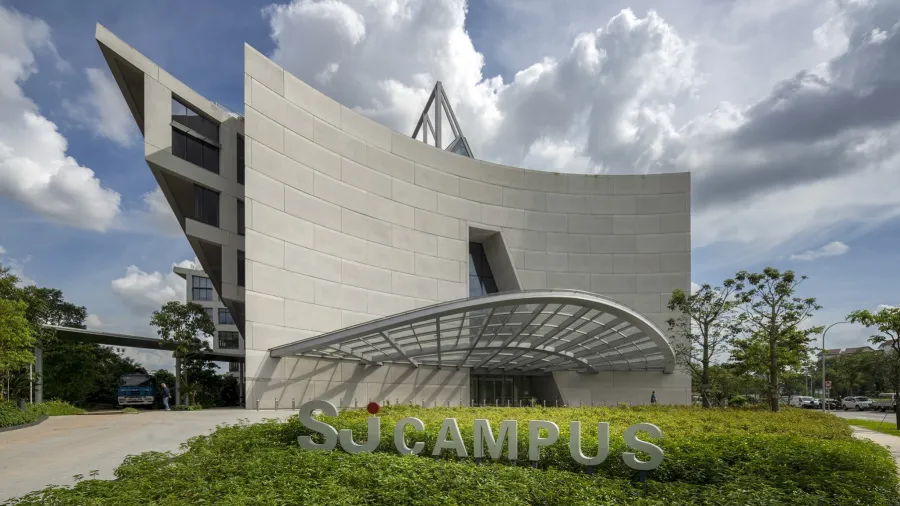
Surbana Jurong’s ‘Campus in Nature’ transcends sustainable innovation, scale employee productivity
The SJ Campus hosts 4,000 of Surbana Jurong’s talent across architecture, engineering, and other teams.
With an ever-growing commitment to innovation and sustainability, global urban, infrastructure, and managed services consulting firm, Surbana Jurong (SJ) designs its new headquarters to be central to sustainable development and collaborative innovation.
Nestled at the heart of the Jurong Innovation District, SJ’s “Campus in Nature” incorporates extensive green spaces and advanced digital facilities, setting a benchmark for SJ's global operations.
“The SJ Campus is an ‘Office in Nature’ within the Jurong Innovation District. Here, people come together to ideate, collaborate, and create, drawing inspiration from the nature that surrounds them,” Sean Chiao, Group CEO of Surbana Jurong told Singapore Business Review.

The Campus stands out for its scale and integration of sustainability and smart technologies, housing employees from various entities in a single cohesive space to promote greater collaboration and efficiency.
It spans a massive 742,000 sq ft of gross floor area, with a built-up area of 1.2 million sq ft, housing 4,000 on-site employees. Within this vast complex, a diverse array of amenities is meticulously integrated to cultivate a conducive environment, promoting workforce well-being and productivity.
“SJ Campus actually supports the group’s growth journey by enhancing collaboration among teams from different disciplines across geographies. The next phase of our transformation demands stronger teamwork than ever, among our global talent,” Chiao said.

The Campus boasts 22,000 sq ft of space dedicated to lifestyle amenities, including F&B outlets, a clinic, and a childcare centre, creating a vibrant mini-city that caters to diverse needs and enhances the quality of life for its community.
These amenities are enclosed within ten interconnected towers with pedestrian pathways and enclosed courtyards, maximising natural light and air circulation.
Campus in Nature
The concept of “Campus in Nature” reflects Singapore’s identity as a “City in Nature,” renowned for its innovation and commitment to sustainability.
Building on Singapore’s reputation for inspiring buildings, SJ tapped Safdie Architects, celebrated for shaping Singapore’s iconic landmarks Marina Bay Sands and Jewel Changi, for the design of their headquarters.
“The design [is] a collaboration between Surbana Jurong’s architects and Safdie Architects, it emphasises sustainability and integration with the natural surroundings, preserving over half of the existing green space and incorporating innovative building techniques like Design for Manufacturing and Assembly (DfMA),” Chiao said.

To maximise the preservation of nature, SJ replaced the built-upon green areas with rooftop gardens, 27,480 sq ft lush indoor gardens, and extensive exterior landscaping. Through thorough mapping, SJ was also able to identify and preserve a Banyan Tree, estimated to be over sixty years old.
The campus’ rooftop gardens and the extensive green spaces harmonise with the natural environment. These spaces not only enhance aesthetic appeal but also promote sustainability by reducing energy consumption and improving air quality.
“The campus has some beautiful views, [with] all the garden space, it doesn't feel like a typical office. [It is] a seamless integration into the natural ecosystem. We have run more than 100 iterations to select the best possible combination where we can bring in more than 2000 lux for four hours in a day so that our plants are happy,” Praveen Hassan Chandrashekar, Director of Sustainability and Resilience at Surbana Jurong said.
It attracts walking trail enthusiasts, birdwatchers, cyclists, and families exploring the vast 114,200 sq ft Jurong Eco-Garden, which features a freshwater swamp, streams, and Singapore’s last two dragon kilns. In addition, it also offers 177 bicycle parking lots.

To maximise sustainability and boost employee comfort and well-being, the SJ Campus offices integrate biophilic elements, effectively capturing natural light and breezes, enhanced by windows overlooking the lush urban garden outside.
Adding to this, Chandrashekar shares: “The entire campus is served with smart lighting controls. We have photo sensors that can maximise energy savings when we have enough daylight coming in.”
According to SJ, biophilic design is proven to increase well-being, productivity, and creativity by 15%. In addition, biophilia can also reduce eye strain by 51%, drowsiness by 56%, and headaches by 63%.
“We are targeting to optimise our systems towards 60% energy savings and preparing ourselves for a net-zero target by 2030,” Chandrashekar said.



![SBR 5 Lorem Ipsum News 2 [8 May]](https://cmg-qa.s3.ap-southeast-1.amazonaws.com/s3fs-public/styles/exclusive_featured_article/public/2025-05/a_hand_pointing_to_a_futuristic_technology_5b87c9d0e3_3.png.webp?itok=M3Hf-9XR)
![SBR 4 Lorem Ipsum [8 May Top Stories]](https://cmg-qa.s3.ap-southeast-1.amazonaws.com/s3fs-public/styles/exclusive_featured_article/public/2025-05/a_hand_pointing_to_a_futuristic_technology_5b87c9d0e3_2.png.webp?itok=2m5Wl0MX)


![Exclusive three SBR 12 Lorem Ipsum [8 May]](https://cmg-qa.s3.ap-southeast-1.amazonaws.com/s3fs-public/styles/exclusive_featured_article/public/2025-05/a_hand_pointing_to_a_futuristic_technology_5b87c9d0e3_11.png.webp?itok=8kn_UIfA)
![SBR 3 Lorem Ipsum [ Exclusive 2]](https://cmg-qa.s3.ap-southeast-1.amazonaws.com/s3fs-public/styles/exclusive_featured_article/public/2025-05/a_hand_pointing_to_a_futuristic_technology_5b87c9d0e3_1.png.webp?itok=YCyjLegJ)
![SBR 2 Lorem Ipsum [8 May]](https://cmg-qa.s3.ap-southeast-1.amazonaws.com/s3fs-public/styles/exclusive_featured_article/public/2025-05/a_hand_pointing_to_a_futuristic_technology_5b87c9d0e3_0.png.webp?itok=_cKD-29o)

![Video [Event News]](https://cmg-qa.s3.ap-southeast-1.amazonaws.com/s3fs-public/styles/event_news_featured_article/public/2025-05/screenshot-2025-05-08-at-4.58.53-pm_0.png.webp?itok=Kud35sMs)
![Event News SBR 9 Lorem Ipsum [8 may]](https://cmg-qa.s3.ap-southeast-1.amazonaws.com/s3fs-public/styles/event_news_thumbnail/public/2025-05/a_hand_pointing_to_a_futuristic_technology_5b87c9d0e3_8.png.webp?itok=DTh_dbYp)
![Event News SBR 9 Lorem Ipsum [8 May]](https://cmg-qa.s3.ap-southeast-1.amazonaws.com/s3fs-public/styles/event_news_thumbnail/public/2025-05/a_hand_pointing_to_a_futuristic_technology_5b87c9d0e3_7.png.webp?itok=vzDAzb6V)
![Event News SBR 8 Lorem Ipsum [8 May]](https://cmg-qa.s3.ap-southeast-1.amazonaws.com/s3fs-public/styles/event_news_thumbnail/public/2025-05/a_hand_pointing_to_a_futuristic_technology_5b87c9d0e3_6.png.webp?itok=jvHFc4P6)
![Video [Event News]](https://cmg-qa.s3.ap-southeast-1.amazonaws.com/s3fs-public/styles/video_thumbnail/public/2025-05/screenshot-2025-05-08-at-4.58.53-pm_0.png.webp?itok=yZnI0YBb)
![Video 1 SBR [8 May]](https://cmg-qa.s3.ap-southeast-1.amazonaws.com/s3fs-public/styles/video_thumbnail/public/2025-05/screenshot-2025-05-08-at-4.58.53-pm.png.webp?itok=9AAeRz_k)

 Advertise
Advertise

